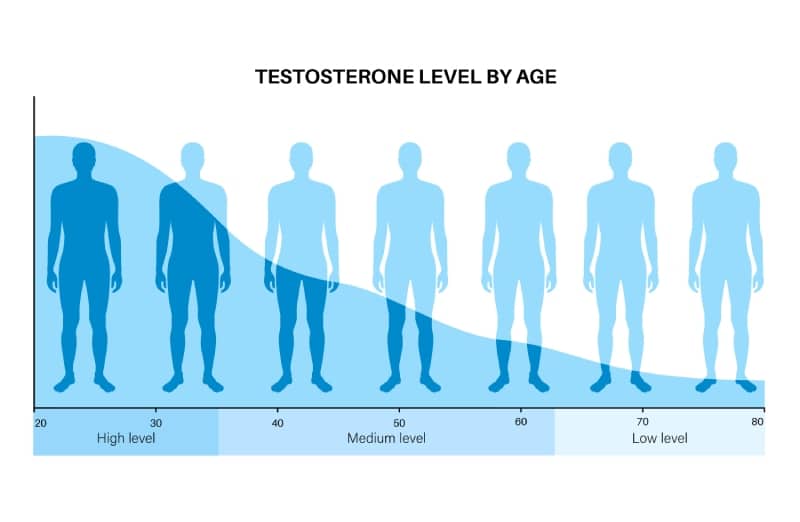Testosterone Levels As We Age: A Decade-by-Decade Exploration
Posted on February 27, 2024 by root

Testosterone, the primary male sex hormone, is crucial for many aspects of male health, including muscle mass, bone density, red blood cell production, and sexual function. However, it’s well-documented that testosterone levels in men begin to decline as part of the natural aging process. This decline can be influenced by various factors, including lifestyle choices and health status. In this blog post, we’ll explore how testosterone levels typically change from the 20s through the 90s and discuss how certain lifestyle factors can impact these levels during each decade of life.
Testosterone Levels by Age
In Your 20s
Men’s testosterone levels peak in their late teens and early 20s. The average range for total testosterone is typically between 300 and 1,000 ng/dL, with the peak average hovering around 700 ng/dL [1]. During this decade, maintaining a healthy lifestyle can help preserve these optimal levels. Regular exercise, especially resistance training and high-intensity interval training (HIIT), adequate sleep (7-9 hours per night), and a balanced diet rich in nutrients can support healthy testosterone levels.
In Your 30s
Starting in the late 20s or early 30s, testosterone levels slowly begin to decline, typically at a rate of about 1% per year [2]. While this decline is natural, maintaining an active lifestyle and managing stress through techniques like meditation or yoga can help mitigate the decrease. Avoiding excessive alcohol consumption and smoking is also crucial during this decade.
In Your 40s
By the 40s, many men start to notice the effects of declining testosterone, such as reduced muscle mass and increased body fat. The average levels might drop to the lower end of the 300-1,000 ng/dL range, typically in the 500-600 range. At this stage, it’s particularly important to manage chronic health conditions like obesity, hypertension, and type 2 diabetes, all of which can exacerbate the decline in testosterone [3].
In Your 50s
As men enter their 50s, they may experience more pronounced symptoms of low testosterone, including decreased libido, fatigue, and mood changes. Testosterone levels often fall below 500 ng/dL during this decade. Healthy eating, including a diet rich in omega-3 fatty acids, and maintaining an active lifestyle are key strategies for managing testosterone levels. Regular health check-ups to monitor cholesterol, blood pressure, and blood sugar levels are also essential.
In Your 60s
The 60s may bring a more significant drop in testosterone levels, with many men having levels well below 450 ng/dL. At this age, it’s crucial to focus on muscle preservation through resistance training and protein intake. Additionally, ensuring adequate vitamin D levels, either through sun exposure or supplementation, can support testosterone production [4].
In Your 70s and Beyond
Testosterone levels continue to decline into the 70s and 80s, often falling below 350 ng/dL. Despite this natural decline, engaging in regular physical activity, managing stress, and maintaining social connections can help improve quality of life and potentially support testosterone levels. It’s also important for men in this age group to discuss any symptoms of low testosterone with their healthcare providers, as testosterone replacement therapy (TRT) may be beneficial for some individuals.
In Your 80s and 90s
While less is known about testosterone levels in men in their 80s and 90s, it’s clear that levels are significantly lower than in younger years. However, focusing on a healthy lifestyle, with an emphasis on diet, exercise, and mental health, remains important for overall well-being.
Lifestyle Factors Impacting Testosterone Levels
Throughout the decades, certain lifestyle factors consistently impact testosterone levels, including:
- Physical activity: Regular exercise, particularly resistance and high-intensity training, can boost or help maintain testosterone levels.
- Diet: A balanced diet that includes whole foods, healthy fats, and lean proteins supports hormone production.
- Stress management: Chronic stress leads to elevated cortisol levels, which can negatively affect testosterone.
- Sleep: Quality sleep is crucial for testosterone production. Poor sleep patterns can significantly lower testosterone levels.
- Health management: Chronic conditions like obesity, diabetes, and metabolic syndrome are linked to lower testosterone levels. Managing these conditions is key to maintaining healthy testosterone levels.
Conclusion
Testosterone levels naturally decline with age, but this doesn’t mean that men are powerless against this trend. By understanding how testosterone levels change with each passing decade and adopting lifestyle habits that support hormone health, men can mitigate some of the effects of aging. Regular exercise, a healthy diet, stress management, and adequate sleep are pillars of maintaining not only healthy testosterone levels but overall well-being as men age.